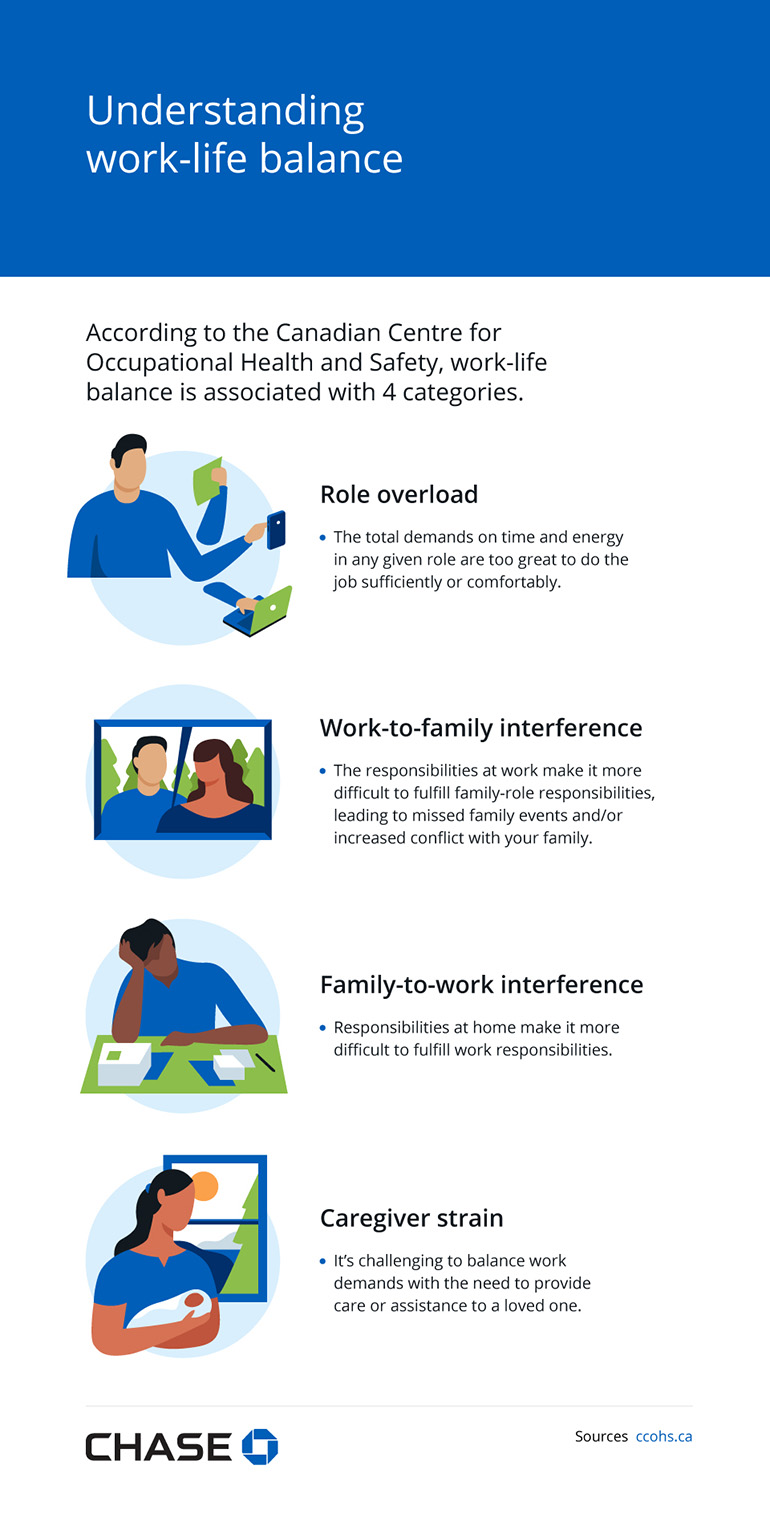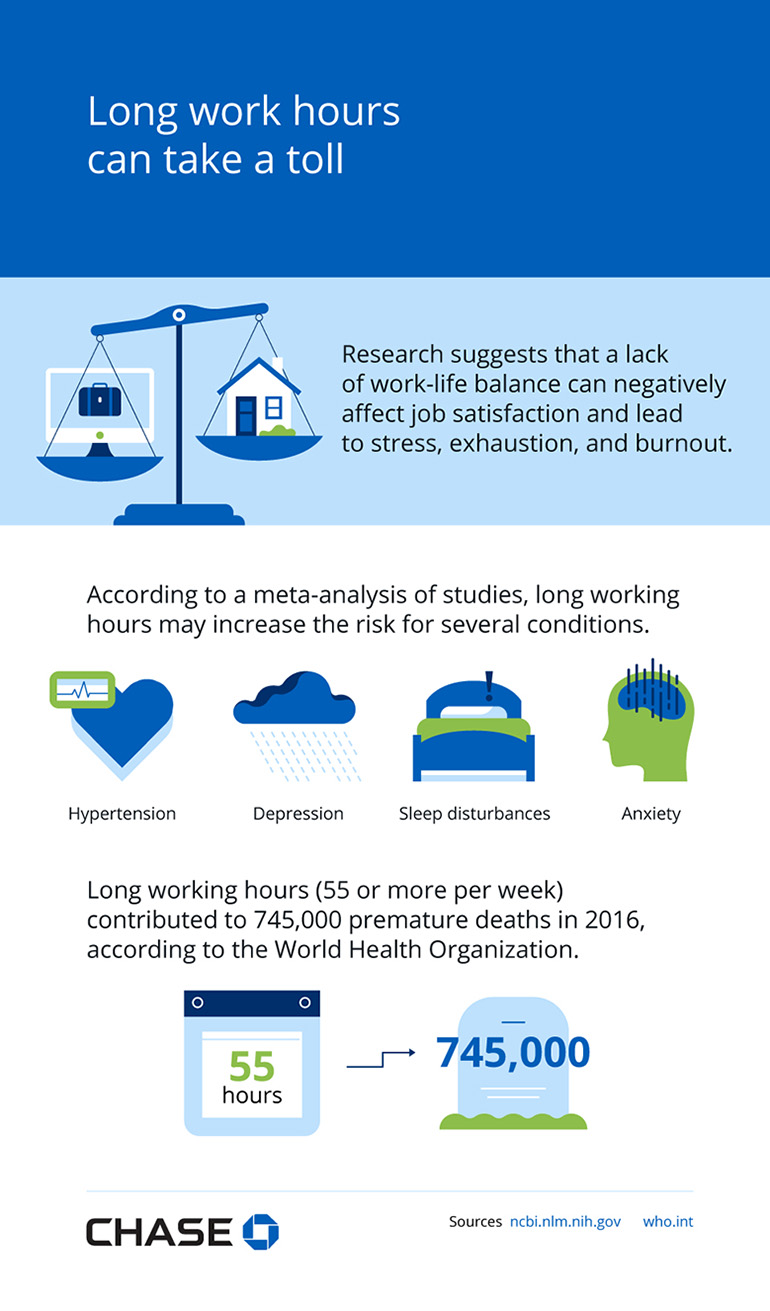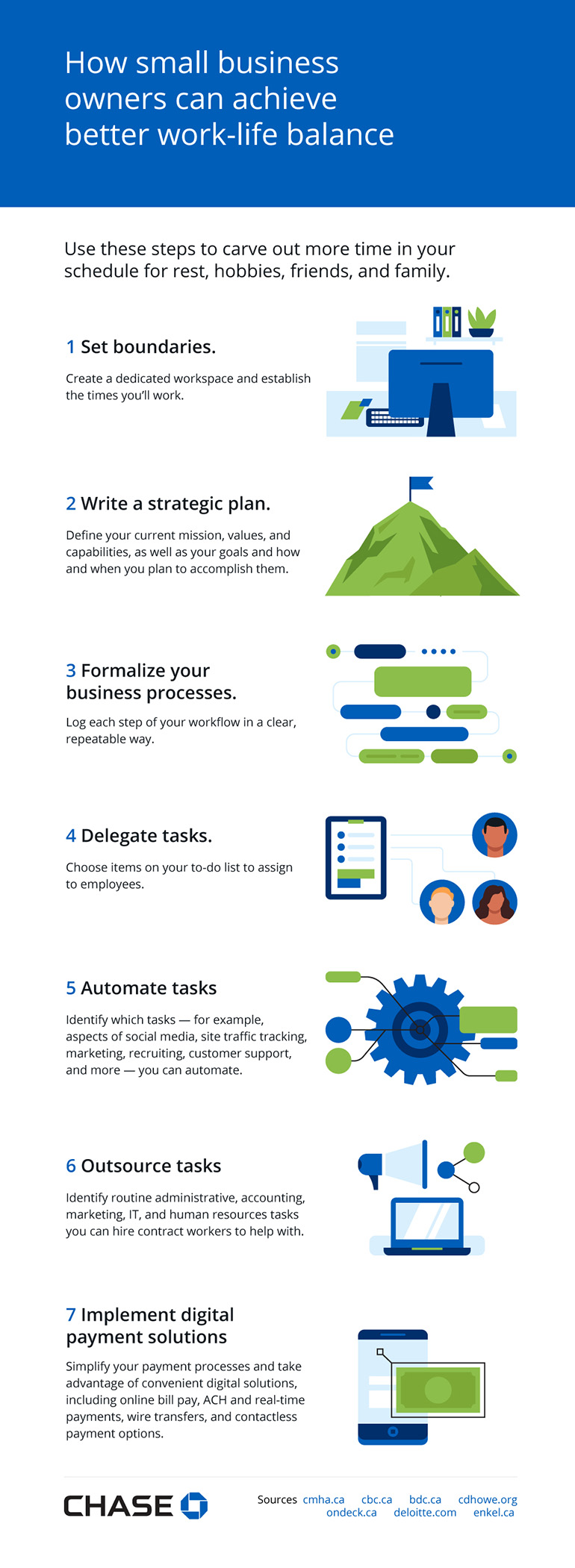A small business owner’s guide to improving work-life balance
By Nicole McDermott

The term “work-life balance” can be elusive since workers have different needs, roles, and ideas of how distanced their work and home lives should be. For the average Canadian full-time worker who logs 39.8 hours on the job per week, it may not be so challenging to find a natural separation between responsibilities at home and in the office. But for entrepreneurs, the waters between those two worlds may look a little muddier. In fact, the most recent BDC survey on SME owners’ mental health (PDF) found that 54% of small business owners cited work-life balance as a source of stress.
So what can small business owners do to improve work-life balance? Keep reading to learn more about the concept, plus helpful strategies to consider.
The demand for more balance
According to the most recent ADP Canada monthly Happiness@Work Index, “work-life balance and flexibility” is a key contributor to job satisfaction. While it’s easy to think that balance comes down to hours logged on the job, finding harmony between life and work isn’t just about time. According to the Canadian Centre for Occupational Health and Safety, work-life balance is associated with four categories.
- Role overload: when the total demands on time and energy in any given role are too great to do the job sufficiently or comfortably
- Work-to-family interference: when responsibilities at work make it more difficult to fulfill family-role responsibilities, leading to missed family events and/or increased conflict with family
- Family-to-work-interference: when responsibilities at home make it more difficult to fulfill work responsibilities
- Caregiver strain: when it’s challenging to balance work demands with the need to provide care or assistance to a loved one

According to the Canadian Centre for Occupational Health and Safety, work-life balance is associated with 4 categories.
Role overload
- The total demands on time and energy in any given role are too great to do the job sufficiently or comfortably.
Work-to-family interference
- The responsibilities at work make it more difficult to fulfill family-role responsibilities, leading to missed family events and/or increased conflict with your family.
Family-to-work interference
- Responsibilities at home make it more difficult to fulfill work responsibilities.
Caregiver strain
- It’s challenging to balance work demands with the need to provide care or assistance to a loved one.
Sources:
What happens when we work too much
Working too much can take a real toll on your health and well-being — especially when you clock in early and leave late day in and day out for weeks, months, or years at a time. In fact, a comprehensive body of research shows that a lack of work-life balance can negatively affect job satisfaction — a major marker of overall well-being and psychological health — and lead to stress, fatigue, and burnout.
But the effects of overwork can go beyond not liking your job and feeling stretched too thin. A recent review study found significant associations between work-related stress and depression, anxiety, heart disease, and diabetes.

Research suggests that a lack of work-life balance can negatively affect job satisfaction and lead to stress, fatigue, and burnout.
According to a recent review study, work-related stress may increase the risk for several conditions.
- Heart disease
- Depression
- Diabetes
- Anxiety
Sources:
- Work–Life Balance: Weighing the Importance of Work–Family and Work–Health Balance (2020, February 1). National Center for Biotechnology Information.
- The Effect of Long Working Hours and Overtime on Occupational Health: A Meta-Analysis of Evidence from 1998 to 2018 (2019, July 13). National Center for Biotechnology Information.
While long working hours can take a real toll, you have the power to lead by example and move toward a state of work-life equilibrium that allows you (and your employees) to even the scales between work and non-work demands.
How to achieve better work-life balance
Consider implementing some or all of the following strategies to help your employees find a greater harmony between their work and their lives.
Set boundaries
When you make a commitment to strive toward better work-life balance, it’s crucial that you create boundaries for yourself. Be realistic about when you need to be available, then let the people who report to you know when and how they can contact you.
If you work from home and you don’t have a commute to separate your home life from the office, set clear physical boundaries by creating a dedicated workspace in your house that you use only for work. And if you feel tempted by your work email or messaging app after hours, schedule downtime, time limits to disconnect, and non-negotiable personal time for rest and relationships.
Lastly, remember it’s one thing to establish boundaries, but another to stick to them. If you disregard your boundaries, you signal to everyone else that they don’t need to respect them either.
Prioritize self-care
Setting boundaries and making time for yourself is the first, crucial step in prioritizing your health and longevity. While self-care can feel like an elusive concept, studies show regular exercise, healthy eating, getting plenty of sleep, staying connected with friends and family, and engaging in hobbies and pastimes is associated with greater overall health, a lower risk for depression, and improved flexibility in the face of work and home stressors. So while it may feel like there simply aren’t enough hours in the day, remember that making room for your mental and physical health can translate to a better — and even more productive — version of you at home and at work.
Write a strategic plan
Maybe you already drafted a strategic plan to clarify your organization's goals when you first started your business. But things change and so should your written plan. A successful strategic plan saves time and headaches by defining your current mission, values, and capabilities, as well as your goals and how and when you plan to accomplish them. Take the time to revisit your strategic plan and ensure it's clear and actionable, with a list of detailed steps to achieve your company’s objectives.

Use these steps to carve out more time in your schedule for rest, hobbies, friends, and family.
- Set boundaries.
Create a dedicated workspace and establish the times you’ll work. - Write a strategic plan.
Define your current mission, values, and capabilities, as well as your goals and how and when you plan to accomplish them. - Formalize your business processes.
Log each step of your workflow in a clear, repeatable way. - Delegate tasks.
Choose items on your to-do list to assign to employees. - Automate tasks.
Identify which tasks — for example, aspects of social media, site traffic tracking, marketing, recruiting, customer support, and more — you can automate. - Outsource tasks.
Identify routine administrative, accounting, marketing, IT, and human resources tasks you can hire contract workers to help with. - Implement digital payment solutions.
Simplify your payment processes and take advantage of convenient digital solutions, including online bill pay, ACH and real-time payments, wire transfers, and contactless payment options.
Sources:
- Work-life Balance: Make it your business (2021, September 21). Canadian Mental Health Association.
- Right-to-disconnect legislation welcome, but experts say workers won't benefit equally (2021, October 31). CBC.
- What is the difference between a business plan and a strategic plan. BDC.
- How to write a strategic plan. BDC.
- 9 steps for delegating work more effectively. BDC.
- Future Shock? The Impact of Automation on Canada’s Labour Market. C.D. Howe Institute (PDF)
- 20 Business Tasks You Can Easily Automate. OnDeck Canada.
- 2020 Global Outsourcing Survey (2020, November 19). Deloitte US.
- 5 Tasks You Should Outsource to Build a Better Business. Enkel
Review and formalize your business processes
Whether you have a small or large team, document your business processes. Log each step in a clear and repeatable way, on separate workflow docs or playbooks, so you can more easily delegate as you take on higher-level strategic work. Once you write down your processes, you may also reveal inefficiencies and potential areas for automation (more on that in a bit).
Delegate tasks
Formalizing your business processes is just one piece of the delegation pie. As a small business owner, it can be incredibly challenging to let go, especially when it comes to entrusting others with important tasks you’ve always been responsible for. But once you delegate some of the items on your to-do list, you’ll have more time to focus on what needs your attention most while proving to your employees that you’re confident in their abilities.
Before offloading responsibilities willy-nilly, take the time to record all your work tasks over several weeks. Then determine which tasks are most important to keep under your purview and which you’re ready to let go of. Once you identify the team members you’d like to delegate the work to, set up time to walk through each workflow doc together. And if you don’t have regular one-on-one meetings scheduled with the employees you delegated to, book a weekly call so each team member has your undivided attention to ask questions until they can fully take the reins — and you can reap the benefits of a lightened workload.
Automate tasks
When automation complements the work you do (PDF), it can save time, increase productivity, and help your organization grow. While it’s easy to get stuck in the daily grind and you may feel overwhelmed by all the automation tools available, an outside consultant can help identify recurring tasks that you may be able to automate and pinpoint which tools suit each task best. Depending on the makeup of your team and the product or service your company offers, you may decide to automate certain aspects of social media, site traffic tracking, marketing, recruiting, customer support, and more.
Outsource tasks
While it makes sense to keep certain tasks in-house, you may choose to outsource others to cut costs, solve capacity issues, and improve your team’s focus on your core demands. So how do you know which tasks to dole out to contractors and freelancers? Once you delegate within the company and automate tasks with the help of digital tools, you may find other jobs that don’t quite fit into either bucket but happen to take your time away from more important and impactful responsibilities. For instance, you may opt to outsource routine administrative, accounting, marketing, IT, and human resources tasks.
Implement digital payment solutions
Just like it’s helpful to automate marketing tasks, recruiting efforts, and everything in between, you can also save time and gain peace of mind by digitizing your payments. To simplify your payment processes, you can take advantage of several convenient digital solutions, including online bill pay, ACH and real-time payments, wire transfers, and contactless payment options.
Balancing the scales
Being a small business owner isn’t easy. Working more and asking your team to do the same may feel like the best way to meet your goals. But while logging long hours can help you achieve short-term gains, it can ultimately lead to burnout and long-term losses.
Achieving and maintaining long-lasting work-life balance is a science and an art. It takes time, patience, and tenacity. When you put the effort into setting boundaries and condensing your workload, you can schedule more quality time with your friends and family while improving your health and showing your work family that you care enough about them and the company to take care of yourself. Investing in work-life balance will benefit your company’s leadership and employees, who in turn, will create a better experience for your customers. It’s a win-win-win strategy.